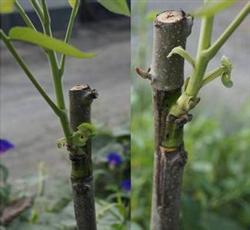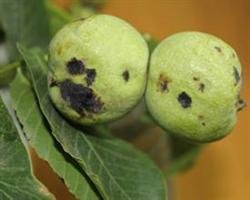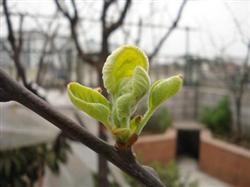Square Bud grafting technique of Walnut

The square bud grafting technique of walnut has the advantages of high survival rate, labor-saving and convenient operation, and the technology is easy to master and popularize, which is suitable for planting young trees and nursery seedlings. The square budding technology is introduced as follows: 1. Grafting time. It can be carried out from late May to mid-July, but the best time is in June, when the grafting survival rate is high and the growth is exuberant. Early, the buds on the scion are too tender, it is not easy to survive after grafting; too late, the growth period of new shoots is short, the maturity of new shoots is low, and it is difficult to survive the winter. two。 Prepare before grafting. Choose scion: choose the fuller buds in the middle and lower part of the current year's new shoots. It is best to choose straight new shoots, try to avoid bow-shaped and triangular new shoots as scions, scion immediately remove leaves, leaving 1 cm long petiole, to prevent water evaporation. It is best to pick up as you pick it up. If you can't pick it up, take good care of it and keep it in a damp and cool place for no more than 72 hours at most. Select rootstocks: when selecting current-year shoots for young trees of two or more years, the growth should be more than 40 cm, or one-year-old branches can be selected, and the diameter of the bud site should be more than 1.2 cm. 3. Grafting steps. Take buds: take rectangular buds or square buds, the upper knife edge is 1 cm from the upper edge of the bud, the lower knife edge is about 1 cm from the lower edge of the petiole, and the width of the petiole on both sides is standard or slightly wider. Can be made as a standard tool for budding, that is, accurate and fast. Rootstock treatment: set the position on the smooth side of the selected rootstock, remove all the lower leaves at the opening, and leave 3 or 4 compound leaves in the upper part to provide nutrition and remove the excess upper tip. Open a mouth equivalent to the budding, you can open the door alone or double. The lower part of the opening can be 2mm more than 3mm, which can be used as a drain for bleeding, so as not to hurt the buds. Paste buds: put the removed buds into the door immediately, paste them, compact them, and tie them tightly. For Luo Guo tree, buds and doors should be well aligned, belly to belly, back to back. With a transparent plastic strip with a width of 1.5cm, wrap it up from 1cm from the lower edge of the wound to 1cm from the upper edge of the knife edge, wrap the bud tightly to prevent water evaporation and Rain Water infiltration, pay attention to expose the bud. 7-10 days after grafting, you can see the survival situation, alive, buds remain green, dead, buds turn brown or black, should be regrafted in time. On the 12th and 13th day, the living buds were obviously dilated. After the buds survive, they should be de-sprouted in time in order to concentrate on feeding. Cutting rootstock: when the grafted new buds germinate 3cm to 5cm, leave 3cm to 5cm branches above the buds, remove all the rest, and gently tie the newly sprouted shoots to the remaining branches to prevent wind break. In addition, the plastic strip should be untied in time according to the growth of the new tip. 4. Management after grafting. After cutting off the upper branches, the new buds grow quickly, but it is not easy to lose leaves in autumn, greedy and prosperous, so corresponding measures should be taken to prevent them from freezing damage. Fertilizer and water control began in late August to prevent overgrowth. Coring was carried out before and after the Beginning of Autumn to improve the Lignification degree of the new branch. Before the leaves fall in the first and middle of September, it is necessary to manually promote its aging, but spray ethephon 50ppm, should not be too high concentration.
- Prev

Measures for control of black spot of walnut
The pathogen of walnut black spot generally overwinters in shoots or buds, and the bacterial liquid secreted by Yanchun mainly harms young fruits, leaves and twigs by wind and rain. Management methods: 1. Overwintering management. After deciduous leaves, tree trunks and branches are smeared to protect the general from spreading germs on the tree, heat preservation, disinfection and frost prevention. Spray tree protection at the same time.
- Next

Key points of planting techniques of kiwifruit (part two)
First, early prevention of diseases and insect pests: before germination and germination period, use 100 to 150 times more barium sulfide for pest control, or 3 to 5 degrees of stone sulfur mixture to kill eggs and overwintering bacteria. After leaf spreading, foliar fertilizer Nongkang 120 was sprayed to supplement fertilizer and prevent disease. Second, early application of budding fertilizer: the result of each tree is restored.
Related
- Moge, come on! The staff of the peasant association in the producing area of cantaloupe were frightened when the crowd gathered.
- Causes and Solutions of low Fruit setting rate of Apple
- Symptoms and control measures of passion fruit virus disease
- Fruit growing lesson: how do apple orchards keep high yields?
- Can you build orchards in the mountains? What are the pros and cons?
- How to manage the coloring period of Crisson grape?
- This paper introduces the processing technology of two kinds of fig products.
- How much is a month for retired teachers in rural areas by 2020?
- How can strawberry planting increase sugar content? We should pay attention to management in many aspects.
- What are the cultivation techniques on how to improve the yield of golden fruit?

